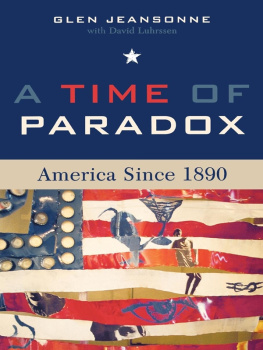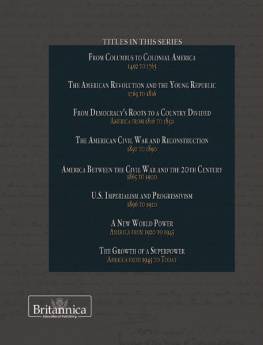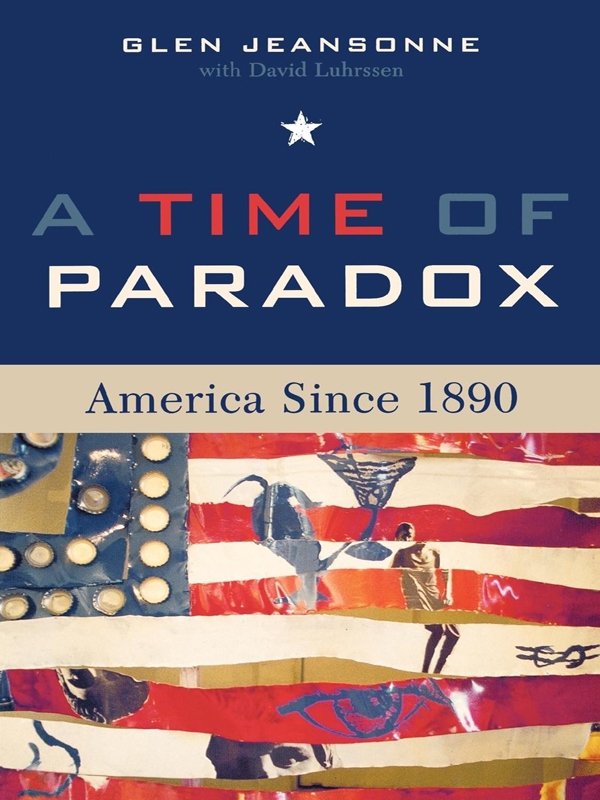Acknowledgments
I EMBARK UPON the prospect of thanking those who contributed to A Time of Paradox with trepidation. Because the genesis of the book is distant, and my memory is fallible, I might omit someone who rendered me valuable service. On the other hand, the help of some might be so subtle they may be surprised to be mentioned.
Bruce Borland, formally of HarperCollins, was crucial in accepting my idea for the book and more than any single editor believed in its trade potential. Mary Carpenter was largely responsible for bringing the book to Rowman and Littlefield. Laura Roberts Gottlieb of Rowman and Littlefield, the books final editor, exercised patience and coaxed out of me the best I could do.
Dozens of referees read portions of the manuscript. However, only Ronald Snyder read the entire manuscript and he wrote the most complete and thoughtful analysis. Of the readers who signed their reports, the most helpful were Leo Ribuffo, who, as usual, was intellectually honest, and Kari Frederickson, a former student, now an established historian.
David Luhrssen worked closely with me, especially in the books final stages. He did the research and wrote the first draft of two of the chapters on cultural history in the Era of Diversity. In addition, he helped with photograph selection, captions, and indexed the manuscript. I turned to Herbert M. Levine whenever I encountered a problem. An old teacher, colleague, and friend, Herb helped with photo and map research. He used his computer skills and strategic location near the Library of Congress to iron out numerous difficulties. I am grateful for the assistance of Michael Gauger, although he did not agree with the final version of the book.
I had a superb copy editor, Ann Grogg, who edited my previous book, Transformation and Reaction . Like most writers I incline to believe that the best strategy to altering my prose is benign neglect. Yet Ann improved it, while adhering to the principle: If it aint broke, dont fix it. Anns husband Bob, who fact-checked, is one of the most meticulous historians I know. Meredith Vnuk checked facts and updated, as did Nick Katers, and Sarah Lager. Stacey Smith aided with photographic research, as did Mary Manion. Jacqueline Kelnhofer was my chief proofreader. Other proofreaders included David Luhrssen, Lori Lasky, and Joan Hoss.
I owe major personal and professional debts to Joan Hoss. She literally lived with the book, typed the final manuscript, and prepared it for submission while I was away researching my next book on Herbert Hoover. Joan and John Kiekhaefer were my chief computer gurus. Though she is not a historian, Joan understands the books underlying message better than anyone who has read it.
Greg Hoag is a wonderful teacher of non-academic truths and Sarah Sullivan, my personal trainer, kept my body intact. Milton Bates advised me on many aspects of the manuscript, including style, content, and publishing strategy, from its inception.
Some of my colleagues lent key support. Neal Pease, Jeffrey Merrick, Joe Rodriguez, and especially Lex Renda helped adjust my teaching schedule to my biorhythms. Among colleagues or former colleagues who suggested sources in their areas of expertise are Michael Gordon, Mark Bradley, Bruce Fetter, Victor Greene, David Hoeveler, and David Healy. No persons in the department were more essential to the books completion than Louise Whitaker, Anita Cathey, and Teena Rawls.
The past and current directors of the Golda Meir Library provided access to its resources and all have been personal friends: Bill Roselle, Peter Watson-Boone, and Ewa Barczyk. My most important friend who navigated me through the labyrinths of library research is Ahmad Kramah, whose knowledge of recent American history is exceeded only by his generosity. Two of my colleagues on the University Library Committee, Winston Van Horne, and Mordecai Lee, have been particularly supportive.
There are several historians from whose work I have profited, some of whom are personal friends: Thomas C. Reeves, John Milton Cooper, William B. Pemberton, David Fromkin, James MacGregor Burns, Michael Beschloss, Dennis Dickerson, James W. Cortada, Thomas Schoonover, John Ehrman, and the late Stephen Ambrose.
I want to acknowledge some of the major influences in my life: my late father, Ryan J. Jeansonne, who knew the New Deal firsthand; the late William Ivy Hair, who steered me through the shoals of graduate school and onto the dry land of an academic career; and Amos E. Simpson, a former teacher and mentor.
For providing the supportive environment that everyone needs, professionally and personally, I would like to thank Helena Pycior, Kathy Callahan, Vann Mobley, Patrick Steele, Stephen A. Webre, Edward F. Haas, Math Allain, Bill Pederson, Paul George, Dan Kohl, Michael Wynne, Eddie Lager, Richard Osborne, Irv Becker, Richard Pierce, Carl Brasseaux, William Warren Rogers, Lynnell Ransome, Bob and Bonnie Bruch, Michael Seeley, Sharon Pace and Anne Shannon.
For inspiration, I had Leah and Hannah Jeansonne.
About the Author
GLEN JEANSONNE has taught twentieth-century American history at the University of LouisianaLafayette, Williams College, and the University of WisconsinMilwaukee. A Time of Paradox is his ninth book, which include Leander Perez (1977), Gerald L. K. Smith (1988), Huey Long (1993), Transformation and Reaction (1994), and Women of the Far Right (1997). Jeansonne received his B.A. in history from the University of LouisianaLafayette, where he graduated salutatorian in 1968, and his Ph.D. from Florida State University in 1973.
DAVID LUHRSSEN has lectured at Marquette University, Beloit College, and the Milwaukee Institute of Art and Design. He has written extensively on music, film, and culture.
EPILOGUE
A Time of Paradox
There is a season for everything, a time for every occupation under heaven: A time for giving birth, a time for dying; a time for planting, a time for uprooting what has been planted. A time for killing, a time for healing; a time for knocking down, a time for building. A time for tears, a time for laughter; a time for mourning, a time for dancing. A time for throwing stones away, a time for gathering them up; a time for embracing, a time to refrain from embracing. A time for searching, a time for losing; a time for keeping, a time for throwing away. A time for tearing, a time for sewing; a time for keeping silent, a time for speaking. A time for loving, a time for hating; a time for war, a time for peace.
Ecclesiastes 3:18
I NTERPRETING the recent past is like hitting a baseball: it is easy to do, but almost impossible to do well. To me, dissecting the Time of Paradox is simple because I have lived through part of it and my memories are fresh, yet difficult, because my feelings are strong. A historian must call third strikes, but judging ones contemporaries might lead one to be hypocritical, mean-spirited, or judgmental. How is a historian to weigh a nation, a time? By Galileos telescope, Napoleons armies, the rebellions of Martin Luther and of Martin Luther King Jr.? Whatever one ventures will be challenged and revised. Generations view history differently. Girls at my daughters high school wear sweatshirts with the peace symbolbut do not know what it meant to members of my generation during the Vietnam War. They wear the symbol because it is cool, an attitude echoed by the girl who told me that her first high school dance was terrible because The music was old. When I asked whether she meant that the music was from the 1950s or the 1960s, from Elvis or the Beatles, she replied, No, last year!




![Jeansonne - A Time of Paradox America Since 1890 [inc VOL 1-2]](/uploads/posts/book/204167/thumbs/jeansonne-a-time-of-paradox-america-since-1890.jpg)

